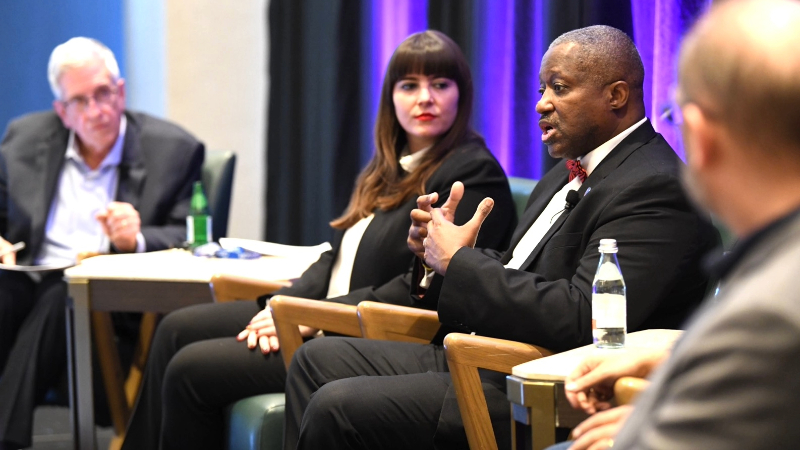
While technology advancements are reshaping the way IT teams work together and driving organizational change across the Federal government, a top tech leader at the Office of Personnel Management (OPM) said Tuesday that a major piece of modernization for better citizen experiences is rooted in training the agency workforce in tech adoption.
OPM’s Deputy Chief Information Officer (CIO) Melvin Brown said during Datadog Observe in Washington, D.C., on Dec. 12 that deploying technology within the government – but failing to train the workforce on how to use it – is not modernization.
“In IT we always think that when we’ve sent the technology out, we’re done. That’s not true. That’s doing IT to someone and not with someone,” Brown said. “We stood up an organizational change management division within our organization. It’s focused specifically on the cultural shift of this is how we used to do it, this is how we’re going to do it in the future, and training people to close that gap.”
“The framework has traditionally been just people, processes, and technology,” the deputy CIO said. “We added a fourth stool to stabilize that and called it learning. And that learning piece has helped us to close the gap from where we were with technology deployment to getting us to where we wanted to be with technology adoption.”
Brown explained some of the ways OPM has implemented the new learning pillar, including a resource center that has reference guides and videos which has helped OPM to shift the culture. Additionally, the deputy CIO explained that the agency has partnered with vendors like Microsoft and Amazon Web Services to offer every OPM employee free classes in different enterprise skills and then help them pay to get a certification to continue improving their skills.
Brown boasted that so far, OPM has certified about 150 of its employees on Microsoft’s Azure cloud fundamentals.
The Cybersecurity and Infrastructure Security Agency’s (CISA) Senior Advisor for Technology and Innovation, Lauren Boas Hayes, said during Datadog Observe that CISA is currently focused on shifting cultural change through its secure by design and default initiative. To do that effectively, she said, it requires collaboration across an entire organization.
“We are really thinking about how does every single person in the organization have a role in either implementing that change or advocating for the type of change that we need to see to get more secure by design and default software,” Hayes said.
A big part of that is information sharing and breaking down silos – not only across the Federal government, but within individual agencies as well – something that CISA works to scale at the national level, and beyond that at the entire technology ecosystem, Hayes said.
Julian Zottl, the chief technology officer of cyber protection solutions at Raytheon, echoed Hayes’ sentiment, reemphasizing the importance that breaking down silos has on cybersecurity across all organizations.
“Literally every part of the business – whether it’s finance, whether it’s the actual network, whether it’s the users, etcetera – are getting attacked, and we can no longer operate in silos,” Zottl said. “We have to work together – every single part, doesn’t matter which part of the organization it is or if it’s part of the government. Everybody has to work together, gather the intelligence to better protect themselves.”
Ketan Patel, the founder and CEO of ArcheSys, said that “everyone has a skin in the game now” when it comes to IT, so shifting the organizational culture to foster better collaboration – and ultimately better customer experiences – is key.
“How we articulate that together as a collective vision and shared responsibility is part of this also,” Patel said. “My success is tied up with your success and that collective success is rising all of us. So, you have to look at it in that perspective.”
“Because now everybody [has] that skin in the game, the motivation is collectively the fastest way to deliver the value to that user,” he added.
CISA’s Hayes explained that while people are usually the biggest challenge when it comes to implementing new technologies, “you need to get people in the door for people to even be a challenge.”
“In cybersecurity, we have an enormous talent gap,” she said. “These are not roles that are open for a week or two. These are roles that organizations struggle to fill for ages.”
Hayes added, “Thinking about that challenge of like to even get to the process of a tech implementation, we’ve got to have fully supported teams. And if we don’t have fully supported teams, the people who are there get burnt out really quickly.”
She said that it’s imperative for the Federal government to begin taking more creative approaches to hiring cyber talent.
“[At] CISA we have our cyber talent management system, which enables us to do resume reviews differently than the traditional government resume review. It enables us to do skills-based tests to bring folks in instead of just pure resume, keyword matching, and things like this,” she continued.
“The more we can think about bringing in people into these roles, who are eager to take on the position and willing to learn, the better we can retain folks that as they grow in their careers, and really empower them to become the leaders in the field to buy down those 700,000 positions that we may not have a perfect fit for today in the nation,” she said.
